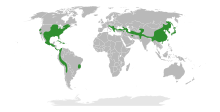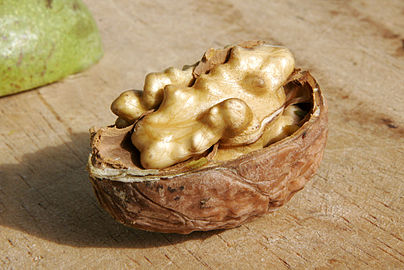
The Fagales are an order of flowering plants, including some of the best-known trees. The order name is derived from genus Fagus, beeches. They belong among the rosid group of dicotyledons. The families and genera currently included are as follows:

In botany, a drupe is an indehiscent type of fruit in which an outer fleshy part surrounds a single shell of hardened endocarp with a seed (kernel) inside. These fruits usually develop from a single carpel, and mostly from flowers with superior ovaries.

The Scrophulariaceae are a family of flowering plants, commonly known as the figwort family. The plants are annual and perennial herbs, as well as shrubs. Flowers have bilateral (zygomorphic) or rarely radial (actinomorphic) symmetry. The Scrophulariaceae have a cosmopolitan distribution, with the majority found in temperate areas, including tropical mountains. The family name is based on the name of the included genus Scrophularia L.
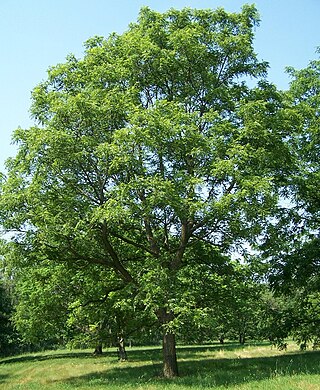
Walnut trees are any species of tree in the plant genus Juglans, the type genus of the family Juglandaceae, the seeds of which are referred to as walnuts. All species are deciduous trees, 10–40 metres (33–131 ft) tall, with pinnate leaves 200–900 millimetres (7.9–35.4 in), with 5–25 leaflets; the shoots have chambered pith, a character shared with the wingnuts (Pterocarya), but not the hickories (Carya) in the same family.

Betulaceae, the birch family, includes six genera of deciduous nut-bearing trees and shrubs, including the birches, alders, hazels, hornbeams, hazel-hornbeam, and hop-hornbeams numbering a total of 167 species. They are mostly natives of the temperate Northern Hemisphere, with a few species reaching the Southern Hemisphere in the Andes in South America. Their typical flowers are catkins and often appear before leaves.
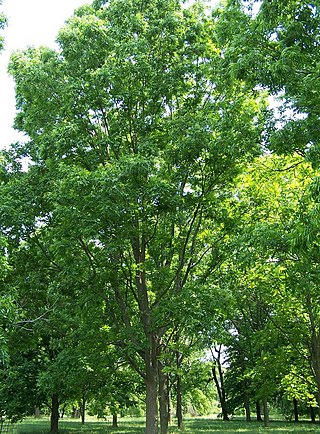
The pecan is a species of hickory native to the southern United States and northern Mexico in the region of the Mississippi River.

A nut is a fruit consisting of a hard or tough nutshell protecting a kernel which is usually edible. In general usage and in a culinary sense, a wide variety of dry seeds are called nuts, but in a botanical context "nut" implies that the shell does not open to release the seed (indehiscent).

Hickory is a common name for trees composing the genus Carya, which includes around 18 species. Five or six species are native to China, Indochina, and India (Assam), as many as twelve are native to the United States, four are found in Mexico, and two to four are native to Canada. A number of hickory species are used for their edible nuts, lumber or other wood and woodcraft products.

Pterocarya, often called wingnuts in English, are trees in the walnut family Juglandaceae. They are native to Asia. The botanic name is from Ancient Greek πτερον (pteron) "wing" + κάρυον (karyon) "nut".

Carya ovata, the shagbark hickory, is a common hickory in the Eastern United States and southeast Canada. It is a large, deciduous tree, growing well over 100 ft (30 m) tall, and can live more than 350 years. The tallest measured shagbark, located in Savage Gulf, Tennessee, is over 150 ft (46 m) tall. Mature shagbarks are easy to recognize because, as their name implies, they have shaggy bark. This characteristic is, however, only found on mature trees; young specimens have smooth bark.

Juglandeae is a tribe of the Juglandoideae subfamily, in the Juglandaceae family.
Carya sinensis is a species of tree native to southwestern China and northern Vietnam, in the hickory genus Carya. It is sometimes called Chinese hickory or beaked hickory. It is closely related to Carya kweichowensis.
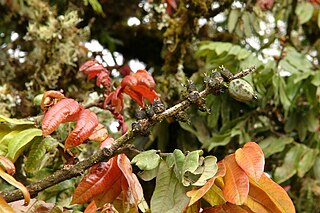
Alfaroa costaricensis, also known as campano chile, chiciscua, gaulin, gavilán Colorado, or gavilancillo, is nut bearing timber tree in the Juglandaceae family. It is native to the Neotropics, from Mexico, through Central America to Colombia.
Alfaroa manningii, or gavilán colorado, is a valued lumber tree of the Walnut family endemic to the premontane Costa Rican rain forest. The specific epithet honors the American botanist Wayne Eyer Manning (1899–2004).

Juglandoideae is a subfamily of the walnut family Juglandaceae.

The pecan weevil, Curculio caryae is an obligate feeder on the nuts of North American hickories and pecans, most widely recognized as an economically important pest of the pecan, Carya illinoinensis. It has also been observed to infest one Juglans species, the Persian walnut, Juglans regia.

Juglandinae is a subtribe of the Juglandeae tribe, of the Juglandoideae subfamily, in the Juglandaceae family. Walnut tree species make up the genus Juglans, which belongs to the subtribe Juglandinae.

Carya pallida, sand hickory, or pale hickory is a species of hickory native to the southeastern United States. It is a perennial, dicotyledonous plant which prefers rocky or sandy habitats. The sand hickory can reach heights of up to 30m, but its typical height is between 9-24m. In an open area, Carya crowns are usually towering and slim. The sand hickory nut is edible and consumed by various organisms.


